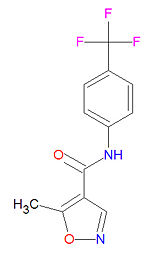Leflunomide: Difference between revisions
imported>David E. Volk (paragraph with structure) |
imported>David E. Volk m (pix size) |
||
| Line 1: | Line 1: | ||
{{subpages}} | {{subpages}} | ||
[[Image:Leflunomide structure.jpg|right|thumb| | [[Image:Leflunomide structure.jpg|right|thumb|150px|{{#ifexist:Template:Leflunomide structure.jpg/credit|{{Leflunomide structure.jpg/credit}}<br/>|}}Leflunomide.]] | ||
'''Leflunomide''', with IUPAC name 5-methyl-N-[4-(trifluoromethyl)phenyl]-1,2-oxazole-4-carboxamide and chemical formula C<sub>12</sub>H<sub>9</sub>F<sub>3</sub>N<sub>2</sub>O<sub>2</sub>, also called leflunomidum and lefunomide, is a pyrimidine synthesis inhibitor belonging to the [[DMARD]] (disease-modifying antirheumatic drug) class of drugs used to treat [[rheumatoid arthritis]] (RA). Activated T cells, which are increased in patients with RA, are dependent on de novo pyrimidine synthesis and will thus be more affected by leflunomide's inhibition of [[dihydroorotate dehydrogenase]] than other cell types that use the salvage pathway of pyrimidine synthesis. | '''Leflunomide''', with IUPAC name 5-methyl-N-[4-(trifluoromethyl)phenyl]-1,2-oxazole-4-carboxamide and chemical formula C<sub>12</sub>H<sub>9</sub>F<sub>3</sub>N<sub>2</sub>O<sub>2</sub>, also called leflunomidum and lefunomide, is a pyrimidine synthesis inhibitor belonging to the [[DMARD]] (disease-modifying antirheumatic drug) class of drugs used to treat [[rheumatoid arthritis]] (RA). Activated T cells, which are increased in patients with RA, are dependent on de novo pyrimidine synthesis and will thus be more affected by leflunomide's inhibition of [[dihydroorotate dehydrogenase]] than other cell types that use the salvage pathway of pyrimidine synthesis. | ||
Revision as of 17:41, 22 January 2008
Leflunomide, with IUPAC name 5-methyl-N-[4-(trifluoromethyl)phenyl]-1,2-oxazole-4-carboxamide and chemical formula C12H9F3N2O2, also called leflunomidum and lefunomide, is a pyrimidine synthesis inhibitor belonging to the DMARD (disease-modifying antirheumatic drug) class of drugs used to treat rheumatoid arthritis (RA). Activated T cells, which are increased in patients with RA, are dependent on de novo pyrimidine synthesis and will thus be more affected by leflunomide's inhibition of dihydroorotate dehydrogenase than other cell types that use the salvage pathway of pyrimidine synthesis.
drug interactions
Leflunomide increases the anticoagulation effects of anisindione, acenocoumarol and dicumarol and warfarin. Rifampin increases the effect of leflunomide.
